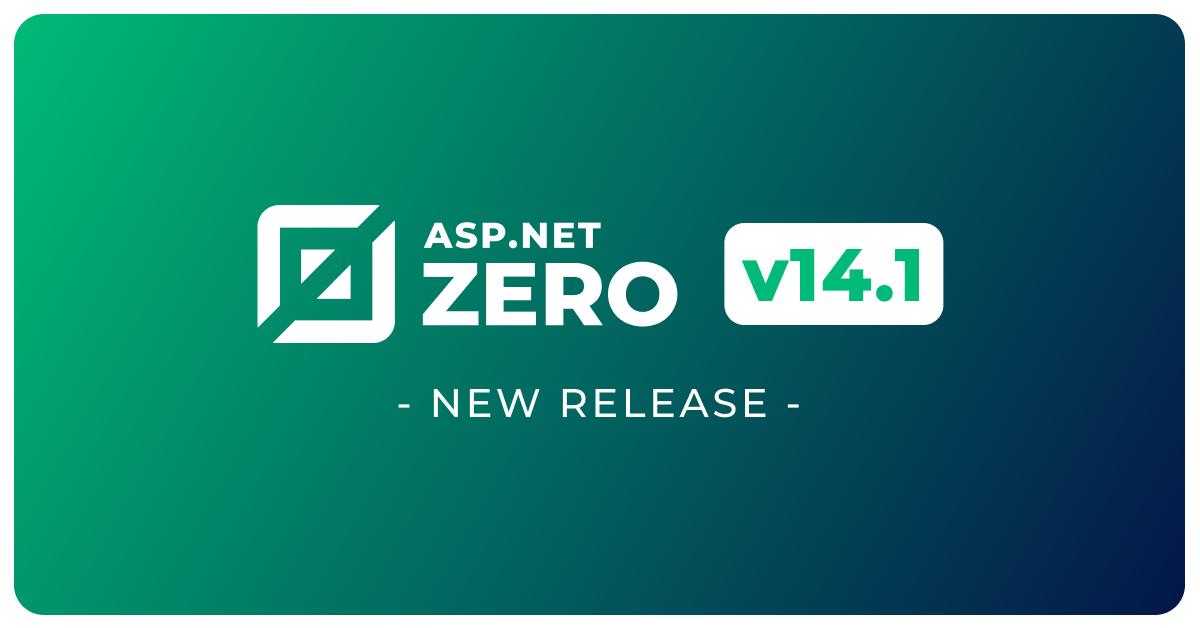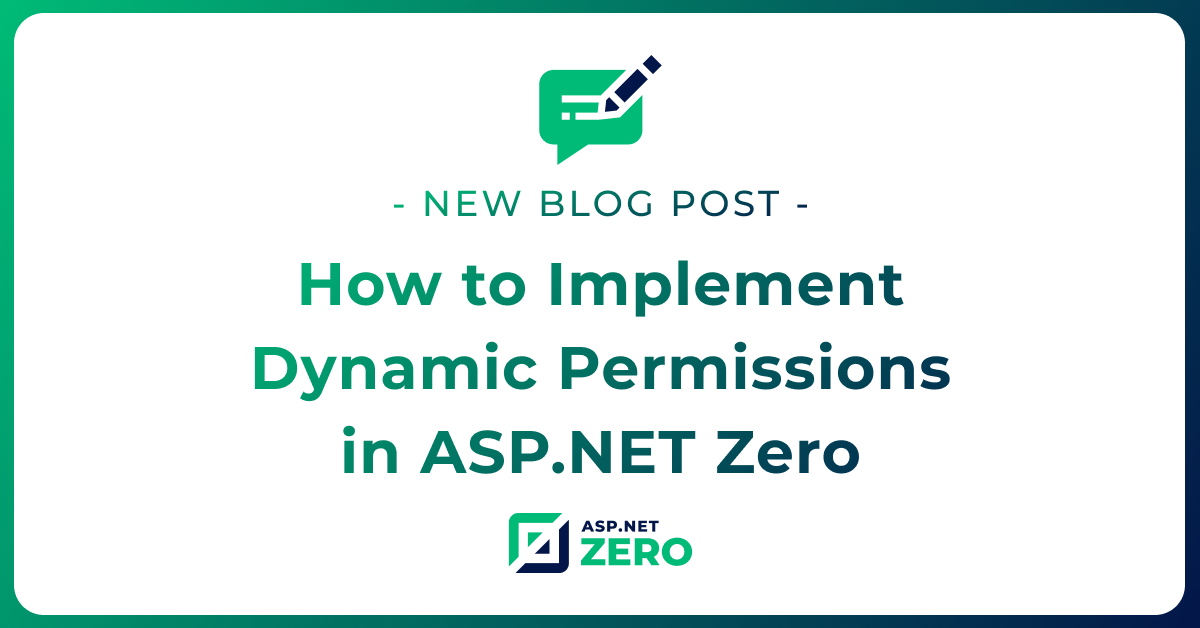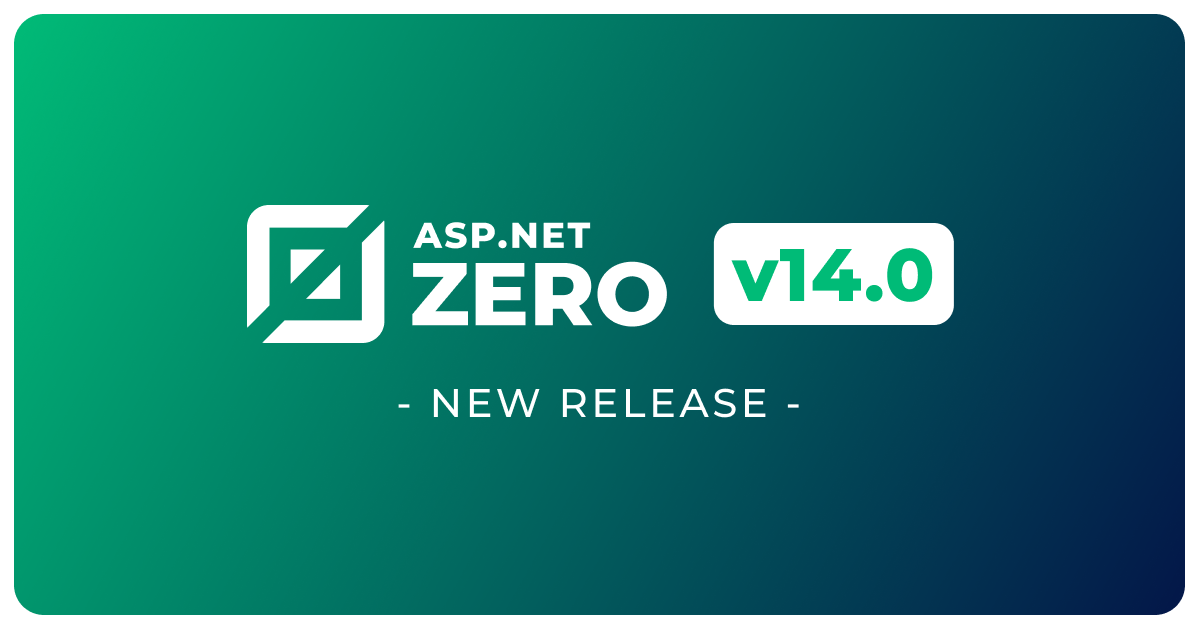Using ASP.NET Zero with DevExtreme Angular Part 1
In this tutorial, we will guide you through the process of creating a robust and feature-rich phonebook application using ASP.NET Zero, which is built on ASP.NET Core and Angular. By following the steps outlined here, you will learn how to develop a multi-tenant application that supports localization, authorization, configurability, and testability.
ASP.NET Zero provides a solid foundation for building enterprise-level applications with its comprehensive set of pre-built features and functionalities. By leveraging the power of ASP.NET Core on the server-side and Angular on the client-side, you can create a modern and responsive web application.
By the end of this tutorial, you will have a solid understanding of how to use ASP.NET Zero Angular and DevExtreme together to develop powerful applications that are both user-friendly and highly functional. So, let's dive in and start building our phonebook application step by step.
Creating & Running The Project
We're creating and downloading the solution named Acme.PhoneBookDemo as described in Getting Started document. Please follow the getting started document, run the application, login as default tenant admin (select Default as tenancy name, use admin as username and 123qwe as the password) and see the dashboard below:

Logout from the application for now. We will make our application single-tenant (we will convert it to multi-tenant later). So, we open PhoneBookDemoConsts class in the Acme.PhoneBookDemo.Core.Shared project and disable multi-tenancy as shown below:
public class PhoneBookDemoConsts
{
public const string LocalizationSourceName = "PhoneBookDemo";
public const string ConnectionStringName = "Default";
public const bool MultiTenancyEnabled = false;
public const int PaymentCacheDurationInMinutes = 30;
}
Note: If you log in before changing MultiTenancyEnabled to false, you might be get login error. To overcome this, you should remove cookies.
Adding a New Menu Item
Let's begin from UI and create a new page named "Phone book".
Defining a Menu Item
Open *\src\app\shared\layout\nav\app-navigation.service.ts in the client side (Acme.PhoneBookDemo.AngularUI) which defines menu items in the application. Create new menu item as shown below (You can add it right after the dashboard menu item).
new AppMenuItem("PhoneBook", null, "flaticon-book", "/app/main/phonebook")
PhoneBook is the menu name (will localize below), null is for permission name (will set it later), flaticon-book is just an arbitrary icon class (from this set) and /phonebook is the Angular route.
If you run the application, you can see a new menu item on the left menu, but it won't work (it redirects to default route) if you click to the menu item, since we haven't defined the Angular route yet.
Localize Menu Item Display Name
Localization strings are defined in XML files in .Core project in server side as shown below:
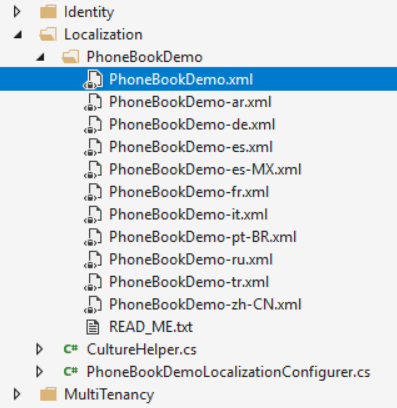
Open PhoneBookDemo.xml (the default, English localization dictionary) and add the following line:
<text name="PhoneBook">Phone Book</text>
If we don't define "PhoneBook"s value for other localization dictionaries, default value is shown in all languages. For example, we can define it also for Turkish in PhoneBookDmo-tr.xml file:
<text name="PhoneBook">Telefon Rehberi</text>
Note: Any change in server side (including change localization texts) requires restart of the server application. We suggest to use Ctrl+F5 if you don't need to debugging for a faster startup. In that case, it's enough to make a re-build to recycle the application.
Angular Route
Angular has a powerful URL routing system. ASP.NET Zero has defined routes in a few places (for modularity, see main menu & layout). We want to add phone book page to the main module. So, open *\src\app\main\main-routing.module.ts in the client side and add a new route just below to the dashboard:
{
path: 'phonebook',
loadChildren: () => import('./phonebook/phonebook.module').then(m => m.PhonebookModule)
}
We get an error since we haven't defined PhoneBookModule yet. Also, we ignored permission for now (will implement later).
Creating the PhoneBook Component
Create a phonebook folder inside *\src\app\main folder and add a
new typescript file phonebook.component.ts as shown below:
import { Component, Injector } from '@angular/core';
import { AppComponentBase } from '@shared/common/app-component-base';
import { appModuleAnimation } from '@shared/animations/routerTransition';
@Component({
templateUrl: './phonebook.component.html',
animations: [appModuleAnimation()]
})
export class PhoneBookComponent extends AppComponentBase {
constructor(
injector: Injector
) {
super(injector);
}
}
We inherited from AppComponentBase which provides some common functions and fields (like localization and access control) for us. It's not required, but makes our job easier.
As we declared in phonebook.component.ts we should create a
phonebook.component.html view in the same folder.
<div [@routerTransition]>
<div class="kt-content kt-grid__item kt-grid__item--fluid kt-grid kt-grid--hor">
<div class="kt-subheader kt-grid__item">
<div [class]="containerClass">
<div class="kt-subheader__main">
<h3 class="kt-subheader__title">
<span>{{"PhoneBook" | localize}}</span>
</h3>
</div>
</div>
</div>
<div [class]="containerClass + ' kt-grid__item kt-grid__item--fluid'"
<div class="kt-portlet kt-portlet--mobile">
<div class="kt-portlet__body kt-portlet__body--fit">
<p>PHONE BOOK CONTENT COMES HERE!</p>
</div>
</div>
</div>
</div>
</div>
l (lower case 'L') function comes from AppComponentBase and used to easily localize texts. @routerTransition attribute is
required for page transition animation.
Now we should create a phonebook.module.ts and phonebook-routing.module.ts view in the same folder:
phonebook-routing.module.ts
import {NgModule} from '@angular/core';
import {RouterModule, Routes} from '@angular/router';
import {PhoneBookComponent} from './phonebook.component';
const routes: Routes = [{
path: '',
component: PhoneBookComponent,
pathMatch: 'full'
}];
@NgModule({
imports: [RouterModule.forChild(routes)],
exports: [RouterModule],
})
export class PhoneBookRoutingModule {}
phonebook.module.ts
import {NgModule} from '@angular/core';
import {AppSharedModule} from '@app/shared/app-shared.module';
import {PhoneBookRoutingModule} from './phonebook-routing.module';
import {PhoneBookComponent} from './phonebook.component';
@NgModule({
declarations: [PhoneBookComponent],
imports: [AppSharedModule, PhoneBookRoutingModule]
})
export class PhoneBookModule {}
Now, we can refresh the page to see the new added page:

Note: Angular-cli automatically re-compiles and refreshes the page when any changes made to any file in the application.
Creating Person Entity
We define entities in .Core (domain) project (in server side). We
can define a Person entity (mapped to PbPersons table in
database) to represent a person in phone book as shown below (I created in a new folder/namespace named PhoneBook):
using System.ComponentModel.DataAnnotations;
using System.ComponentModel.DataAnnotations.Schema;
using Abp.Domain.Entities.Auditing;
namespace Acme.PhoneBookDemo.PhoneBook
{
[Table("PbPersons")]
public class Person : FullAuditedEntity
{
public const int MaxNameLength = 32;
public const int MaxSurnameLength = 32;
public const int MaxEmailAddressLength = 255;
[Required]
[MaxLength(MaxNameLength)]
public virtual string Name { get; set; }
[Required]
[MaxLength(MaxSurnameLength)]
public virtual string Surname { get; set; }
[MaxLength(MaxEmailAddressLength)]
public virtual string EmailAddress { get; set; }
}
}
Person's primary key type is int (as default). It inherits FullAuditedEntity that contains creation, modification and deletion audit properties. It's also soft-delete. When we delete a person, it's not deleted by database but marked as deleted (see entity and data filters documentations for more information). We created consts for MaxLength properties. This is a good practice since we will use same values later.
We add a DbSet property for Person entity to PhoneBookDemoDbContext class defined in .EntityFrameworkCore project.
public class PhoneBookDemoDbContext : AbpZeroDbContext<Tenant, Role, User, PhoneBookDemoDbContext>
{
public virtual DbSet<Person> Persons { get; set; }
//...other code
}
Database Migrations for Person
We use EntityFramework Code-First migrations to migrate database schema. Since we added Person entity, our DbContext model is changed. So, we should create a new migration to create the new table in the database.
Creating Migration
Open Package Manager Console, run the Add-Migration "Added_Persons_Table" command as shown below:

This command will add a migration class named Added_Persons_Table as shown below:
public partial class Added_Persons_Table : Migration
{
protected override void Up(MigrationBuilder migrationBuilder)
{
migrationBuilder.CreateTable(
name: "PbPersons",
columns: table => new
{
Id = table.Column(nullable: false)
.Annotation("SqlServer:ValueGenerationStrategy", SqlServerValueGenerationStrategy.IdentityColumn),
CreationTime = table.Column(nullable: false),
CreatorUserId = table.Column(nullable: true),
DeleterUserId = table.Column(nullable: true),
DeletionTime = table.Column(nullable: true),
EmailAddress = table.Column(maxLength: 255, nullable: true),
IsDeleted = table.Column(nullable: false),
LastModificationTime = table.Column(nullable: true),
LastModifierUserId = table.Column(nullable: true),
Name = table.Column(maxLength: 32, nullable: false),
Surname = table.Column(maxLength: 32, nullable: false)
},
constraints: table =>
{
table.PrimaryKey("PK_PbPersons", x => x.Id);
});
}
protected override void Down(MigrationBuilder migrationBuilder)
{
migrationBuilder.DropTable(
name: "PbPersons");
}
}
We don't have to know so much about format and rules of this file. But, it's suggested to have a basic understanding of migrations. In the same Package Manager Console, we write Update-Database command in order to apply the new migration to database. After updating, we can see that PbPersons table is added to database.
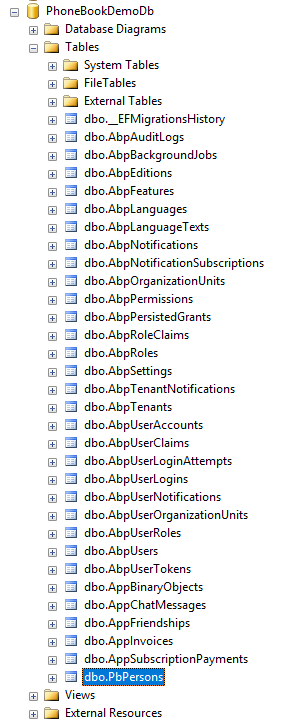
But this new table is empty. In ASP.NET Zero, there are some classes to fill initial data for users and settings:
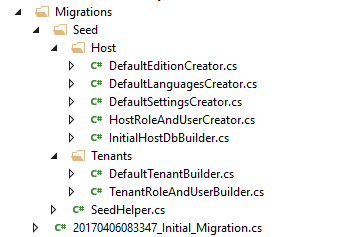
Seed Person Data
So, we can add a separated class to fill some people to database as shown below:
namespace Acme.PhoneBookDemo.Migrations.Seed.Host
{
public class InitialPeopleCreator
{
private readonly PhoneBookDemoDbContext _context;
public InitialPeopleCreator(PhoneBookDemoDbContext context)
{
_context = context;
}
public void Create()
{
var douglas = _context.Persons.FirstOrDefault(p => p.EmailAddress == "[email protected]");
if (douglas == null)
{
_context.Persons.Add(
new Person
{
Name = "Douglas",
Surname = "Adams",
EmailAddress = "[email protected]"
});
}
var asimov = _context.Persons.FirstOrDefault(p => p.EmailAddress == "[email protected]");
if (asimov == null)
{
_context.Persons.Add(
new Person
{
Name = "Isaac",
Surname = "Asimov",
EmailAddress = "[email protected]"
});
}
}
}
}
These type of default data is good since we can also use these data in unit tests. Surely, we should be careful about seed data since this code will always be executed in each PostInitialize of your PhoneBookEntityFrameworkCoreModule. This class (InitialPeopleCreator) is created and called in InitialHostDbBuilder class. This is not so important, just for a good code organization (see source codes).
public class InitialHostDbBuilder
{
//existing codes...
public void Create()
{
//existing code...
new InitialPeopleCreator(_context).Create();
_context.SaveChanges();
}
}
We run our project again, it runs seed and adds two people to PbPersons table:

Conclusion
In this tutorial, we have explored the process of creating a phonebook application using ASP.NET Zero, which is built on ASP.NET Core and Angular, and integrated with DevExtreme components.
Summary
We started by creating and setting up the ASP.NET Zero solution, following the instructions in the Getting Started document. We logged in as the default tenant admin and familiarized ourselves with the dashboard.
We made the application single-tenant by disabling multi-tenancy in the
PhoneBookDemoConstsclass.Next, we added a new menu item for the phonebook page by defining a menu item in the
AppNavigationServiceclass. We also localized the menu item display name by adding the necessary entries in the localization XML files.We defined the Angular route for the phonebook page by adding a new route in the
main-routing.module.tsfile. We created the corresponding components and modules for the phonebook page and implemented a basic layout and content.Moving to the server-side, we created a
Personentity to represent a person in the phonebook and added it to thePhoneBookDemoDbContext.We used Entity Framework Code-First Migrations to create a new migration for the
Personentity and applied it to the database. This created thePbPersonstable in the database.Finally, we added seed data to the
Persontable using theInitialPeopleCreatorclass, which was called in theInitialHostDbBuilder. This allowed us to have some initial data in the database.
What's Next?
In the next tutorial, we will add a application service to manage the phonebook. We will also add a unit test for the application service. Finally, we will add a new page to the Angular application to display the phonebook.
See the next part of this tutorial.

